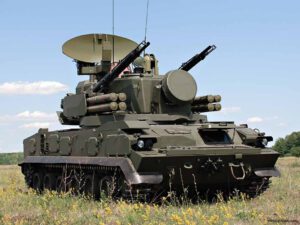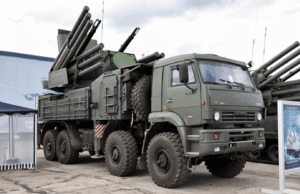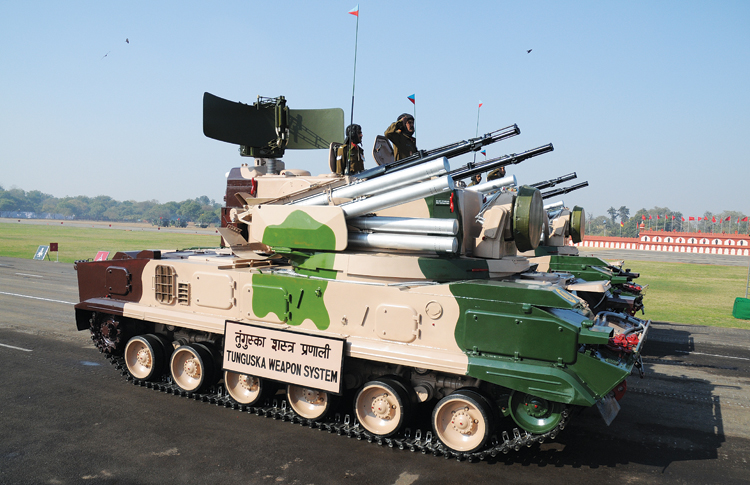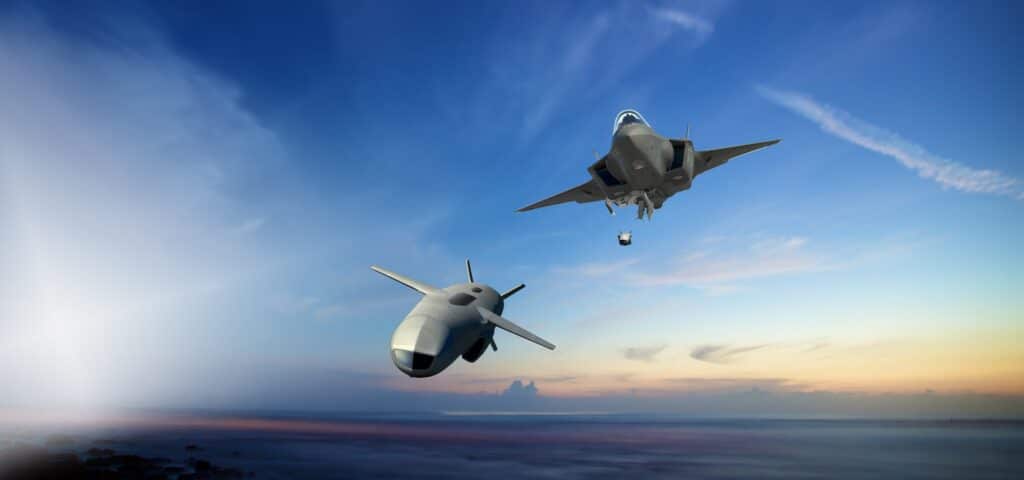Featured Image Source: SP’s Land Forces.[1]
Keywords: India, Air Defence; Indigenisation; Defence Production.
Introduction
On June 4, 2021, the Defence Acquisition Council (DAC) of the Indian Ministry of Defence (MoD) headed by the Defence Minister Rajnath Singh approved the “Purchase of indigenous air defence guns” and “ammunition” amounting to Rs. 6,000 crore INR (approx. 0.9 billion USD).[2] The said acquisition is expected to include air defence guns and Surface to Air Missiles (SAMs) that could provide effective aerial defence against threats including low-level aircrafts, helicopters, Unmanned Aerial Vehicles (UAVs), Precision-Guided Munitions (PGMs), and cruise missiles. The decision to acquire such weapons was to encourage domestic arms manufacturers, made under Prime Minister Narendra Modi’s initiative of “AtmaNirbhar Bharat” (Buy and Make in India or self-reliant India).[3] However, due to unforeseen reasons, the acquisition was delayed, and Janes reported on October 13, 2022, that the programme was restarted.[4]
In plain language, the recent purchase order is a combination of indigenously produced air defence guns and missile system mounted on a self-propelled vehicle, which is likely to be a wheeled or a tracked vehicle having armour protection against small arms fire. Theoretically, the capabilities of the proposed system are much similar to the Russian Pantsir S1 air-defence missile-gun system mounted on a self-propelled 8 x 8 wheeled platform. The latter is claimed to be capable of performing as a stand-alone Close-In Weapon System (CIWS) being capable enough of countering cruise missiles, free-fall bombs, and PGMs in flight.[5]
According to the Indian sources, the Self-Propelled Air Defence Gun Missile System (SPAD-GMS) will be produced locally by the Indian bidders. However, the production will be carried out specifically under the operational requirements and guidelines of the Indian Army. The latter required replacements for its ageing Soviet-built ZU-23 twin-barrel 23 mm, and Swedish-built Bofors L-70 40 mm single barrel Anti-Aircraft Artillery (AAA). Both of the systems were towed, and their mobility was limited.
Before the decision, the Indian Army tested South Korean K-30 Biho 30 mm twin barrel and guided missile-armed self-propelled AAA, and Russian gun-missile systems Tunguska M1[6] (SA-19 Grison) (Figure 1) and Panstir S1 (SA-22 Greyhound) (Figure 2).[7] Later, the K-30 was selected and an order of a total of 104 units was placed amounting to 2.6 billion USD; however, under PM Modi’s initiative of AtmaNirbhar Bharat, the deal was cancelled in September 2020 in favour of the 0.9 billion USD indigenously produced arsenal.[8] In other words, a policy of austerity was adopted in the wake of Covid-19 that was also aimed to strengthen the local defence industry.

Figure 1: [9]

Figure 2: [10]
Previous Acquisition: The Integrated Air Defence Weapon System
In February 2020, the United States approved the sale of an Integrated Air Defence Weapon System (IADWS) amounting to 1.867 billion USD to India upon the latter’s request.[11] The bid included the acquisition of Thales Raytheon Systems’ AN/MPQ-64 F1 Improved Sentinel X-band radar (Figure 3). Contemporarily, it is one of the most advanced tactical air defence radars available in the defence market and more importantly, it is capable of interoperability. In this way, the radar can provide acquisition and tracking data to Very Short-Range Air Defence (VSHORAD) and Short-Range Air Defence (SHORAD) systems. The most important aspect of the radar is its integrated Identification Friend or Foe (IFF) which distinguishes between friendly forces and enemy targets to minimize friendly fire and collateral damage. It is also equipped with Electronic Counter-Countermeasures (ECCM) to withstand electronic warfare and has the potential in jamming enemy communications.[12] The Table 1 shows the major specifications of the radar.
![Figure 3: AN/MPQ-64 F1 Improved Sentinel on Mercedes-Benz G-Class.[13]](https://defensetalks.com/wp-content/uploads/2022/12/Figure-3-ANMPQ-64-F1-Improved-Sentinel-on-MercedesBenz-GClass.13-300x200.jpg)
| Specifications | |
| Radar Type | X-band (8 to 12.5 GHz)
Three-dimensional Range-gated pulse doppler Phase and frequency scanning 30 rpm with electronic back-scan |
| Secondary Radar and Features | AN/TPX-56
Integrated IFF ECCM |
| Track Selector | Elevation: -10 degrees to +55 degrees
Azimuth: 360 degrees |
| Range | Target acquisition 75-80 km
Target detection 100-120 km |
| Altitude | 40 km (maximum) |
Table 1: The major specifications of the Improved Sentinel.[14]
Analysis and Examination
The AAA or Air Defence Artillery (ADA) pieces have a commendable history in offensive as well as defensive roles, and in maintaining conventional deterrence. Despite their configuration of being self-propelled or towed, their mobility and all-weather operational capability further add tactical, operational, and even strategic advantages.
The Indian Army’s decision to acquire such a combination of weapons would surely enhance its air defence capabilities and they can be effectively used against Pakistan or China. The topography as well as terrain of India’s frontline regions in the North and North-West are rugged and mountainous. The latter conditions require deployment of air defence equipment via helicopters, as such elevated positions are not accessible otherwise. This tactical advantage can impede hostile aerial incursions by providing timely tracking and acquisition of airborne targets and could change the outcome of entire operations. Had a couple of these systems been deployed in the Indian Illegally Occupied Jammu and Kashmir (IIOJK), it could have made Pakistan Air Force’ (PAF) Operation Swift Retort a lot more difficult. Or at least, the aerial launch of Stand-Off Weapons (SOW) such as the indigenously produced H-2 and H-4 could have been detected, tracked, and even intercepted mid-air.[15] The Operation Swift Retort was successfully executed by PAF in response to the unsuccessful aerial incursion into Pakistan by the Indian Air Force (IAF) in February 2019. The IAF was embarrassed as its unsuccessful attempt resulted in the destruction of 2 of its fighter aircrafts at the hands of PAF in an aerial combat, including a Mig-21 and Su-30 MKI.[16]
The acquisition of new radars and air defence guns could significantly enhance Indian Army’s offensive operational capabilities and such endeavours retain the potential in significantly reinvigorating the “division sized” Integrated Battle Groups (IBGs) of the much-hyped Cold Start Doctrine (CSD).[17] The brain of the modernization of air defence remains the AN/MPQ-64 F1 Improved Sentinel air surveillance radar which is specifically designed to be deployed at the division level. The Improved Sentinel’s division-sized design and CSD’s division-sized IBGs do not have a surprising link; its acquisition was thoroughly planned and the result of careful considerations. It weighs around 2-tons and can be transported using low to medium-lift transport aircrafts and can be airlifted by utility helicopters via sling. The radar is usually installed on trailer to be towed and it can also be mounted on tracked as well as wheeled vehicles for increased mobility.
The U.S. armed forces mounted it on the High Mobility Multi-Purpose Wheeled Vehicles or HMMWVs and the Indian Army is likely to employ the locally produced vehicles by Tata or Mahindra Motors to fully realise the mobility potential of the Improved Sentinel. The same radar is used by the North Atlantic Treaty Organization (NATO) members in the Baltic region to perform point defence roles due to the radar’s vivid three-dimensional pencil beam projection for the detection and acquisition of targets.[18]
It is very important to note that AN/MPQ-64 F1 Improved Sentinel radar can be linked with the indigenously produced Akash Mk1/Mk1S and the Quick Reaction Surface-to-Air Missile (QRSAM).[19] The Akash and QRSAM are likely to provide low to medium range air defence against a variety of aerial targets.
Further, these effective weapons and the AAAs could be readily used as Infantry Fighting Vehicles (IFVs) for infantry fighting roles due to their high Rounds Per Minute (RPM) and superior firepower.
Conclusions
India’s new Self-Propelled Air Defence Gun Missile System (SPAD-GMS) could be a step towards improved Operations Security (OPSEC) of its forward deployed ground forces. Moreover, besides providing point defence capabilities against cruise missiles, free-fall bombs, and PGMs, the SPAD-GMS retains the potential of providing considerable OPSEC for the division sized fighting forces, most importantly the hypothesised IBGs of the proposed Cold Start. However, the linchpin of the system remains the U.S.-built AN/MPQ-64 F1 Improved Sentinel X-band radar.
In hindsight, it is not difficult to conclude that India’s SPAD-GMS would not only enhance the warfighting capabilities of the Indian Army and the other branches of the armed forces, but it would make India more reliant on indigenously produced defence equipment. Such ventures could attract export and the joint production of such equipment.
[1] Lt General Naresh Chand, “Air Defence Guns — Current and Future Relevance,” SP’s Land Forces, 2018, https://www.spslandforces.com/story/?id=571&h=Air-Defence-Guns-andmdash;-Current-and-Future-Relevance.
[2] “Purchase of Indigenous Air Defence Guns, Ammunition Worth Rs 6,000 Crore Cleared,” The Economic Times, June 4, 2021, https://economictimes.indiatimes.com/news/defence/purchase-of-indigenous-air-defence-guns-ammunition-worth-rs-6000-crore-cleared/articleshow/83234214.cms?from=mdr.
[3] “Aatma Nirbhar Bharat,” National Informatics Centre, Ministry of Electronics & Information Technology, Government of India, August 14, 2020, https://aatmanirbharbharat.mygov.in/.
[4] Kapil Kajal, “Indian Army Restarts Air-Defence Guns Procurement,” Janes.Com, October 13, 2022, https://www.janes.com/defence-news/news-detail/indian-army-restarts-air-defence-guns-procurement.
[5] “Pantsir S-1,” Missile Threat, July 6, 2021, https://missilethreat.csis.org/defsys/pantsir-s-1/.
[6] India possesses a couple of Tunguska systems, please see: Sheershoo Deb, “Full List of India’s Air Defence Systems,” DefenceXP – Indian Defence Network, August 23, 2020, https://www.defencexp.com/full-list-of-indian-air-defence-systems/.
[7] Rahul Bedi, “Indian Army’s Persistent Penchant for ‘Marvel Comics Weaponry’ Has Again Cost It Dear,” The Wire, August 27, 2022, https://thewire.in/security/air-defence-gun-missile-system-indian-army-marvel-comics.
[8] “South Korean Sale of K-30 Biho Anti-Aircraft Systems to India Threatened,” Army Recognition, January 8, 2019, https://www.armyrecognition.com/january_2019_global_defense_security_army_news_industry/south_korean_sale_of_k-30_biho_anti-aircraft_systems_to_india_threatened.html.
[9] “Tunguska,” Military Today, 2022, http://www.military-today.com/missiles/tunguska.htm.
[10] “Pantsir S-1.”
[11] “India – Integrated Air Defense Weapon System (IADWS) and Related Equipment and Support,” Defense Security Cooperation Agency, February 10, 2020, https://www.dsca.mil/press-media/major-arms-sales/india-integrated-air-defense-weapon-system-iadws-and-related-equipment.
[12] Michael J. Lostumbo et al., Air Defense Options for Taiwan: An Assessment of Relative Costs and Operational Benefits (Santa Monica, California: RAND Corporation, 2016), 29.
[13] “Raytheon MPQ-64F1 Improved Sentinel Radar,” Kongsberg Defence an Aerospace, 2022, https://www.kongsberg.com/kda/what-we-do/defence-and-security/integrated-air-and-missile-defence/nasams-air-defence-system/raytheon-mpq64f1-sentinel-radar/.
[14] Ibid.
[15] “PAF ‘Operation Swift Retort’ and the Effectiveness of Air Power,” PAF Falcons, May 26, 2019, https://paffalcons.com/paf-operation-swift-retort-and-the-effectiveness-of-air-power/.
[16] Maj. Gen. Ashok K. Mehta, “Only Time Will Tell Whether the Balakot Air Strikes Were a Gamechanger or Not,” Force, June 2019, https://forceindia.net/guest-column/guest-column-ashok-k-mehta/the-jury-is-still-out/.
[17] For a detailed account on India’s Cold Start Doctrine and its Integrated Battle Groups, please see: Muhammad Ali Baig and Hamid Iqbal, “A Comparative Study of Blitzkrieg and Cold Start Doctrine: Lessons and Countermeasures for Pakistan,” IPRI Journal 18, no. 1 (Winter 2018): 1–31.
[18] Christopher Harper, Tony Lawrence, and Sven Sakkov, “Air Defence of the Baltic States” (Tallinn, Estonia: International Centre for Defence and Security, May 2018), 13.
[19] Ankit Panda, “US Approves Possible Sale of an Integrated Air Defense Weapon System for India,” The Diplomat, February 11, 2020, https://thediplomat.com/2020/02/us-approves-possible-sale-of-an-integrated-air-defense-weapon-system-for-india/.
Bibliography
National Informatics Centre, Ministry of Electronics & Information Technology, Government of India. “Aatma Nirbhar Bharat,” August 14, 2020. https://aatmanirbharbharat.mygov.in/.
Baig, Muhammad Ali, and Hamid Iqbal. “A Comparative Study of Blitzkrieg and Cold Start Doctrine: Lessons and Countermeasures for Pakistan.” IPRI Journal 18, no. 1 (Winter 2018): 1–31.
Bedi, Rahul. “Indian Army’s Persistent Penchant for ‘Marvel Comics Weaponry’ Has Again Cost It Dear.” The Wire, August 27, 2022. https://thewire.in/security/air-defence-gun-missile-system-indian-army-marvel-comics.
Chand, Lt General Naresh. “Air Defence Guns — Current and Future Relevance.” SP’s Land Forces, 2018. https://www.spslandforces.com/story/?id=571&h=Air-Defence-Guns-andmdash;-Current-and-Future-Relevance.
Deb, Sheershoo. “Full List of India’s Air Defence Systems.” DefenceXP – Indian Defence Network, August 23, 2020. https://www.defencexp.com/full-list-of-indian-air-defence-systems/.
Harper, Christopher, Tony Lawrence, and Sven Sakkov. “Air Defence of the Baltic States.” Tallinn, Estonia: International Centre for Defence and Security, May 2018.
Defense Security Cooperation Agency. “India – Integrated Air Defense Weapon System (IADWS) and Related Equipment and Support,” February 10, 2020. https://www.dsca.mil/press-media/major-arms-sales/india-integrated-air-defense-weapon-system-iadws-and-related-equipment.
Kajal, Kapil. “Indian Army Restarts Air-Defence Guns Procurement.” Janes.Com, October 13, 2022. https://www.janes.com/defence-news/news-detail/indian-army-restarts-air-defence-guns-procurement.
Lostumbo, Michael J., David R. Frelinger, James Williams, and Barry Wilson. Air Defense Options for Taiwan: An Assessment of Relative Costs and Operational Benefits. Santa Monica, California: RAND Corporation, 2016.
Mehta, Maj. Gen. Ashok K. “Only Time Will Tell Whether the Balakot Air Strikes Were a Gamechanger or Not.” Force, June 2019. https://forceindia.net/guest-column/guest-column-ashok-k-mehta/the-jury-is-still-out/.
PAF Falcons. “PAF ‘Operation Swift Retort’ and the Effectiveness of Air Power,” May 26, 2019. https://paffalcons.com/paf-operation-swift-retort-and-the-effectiveness-of-air-power/.
Panda, Ankit. “US Approves Possible Sale of an Integrated Air Defense Weapon System for India.” The Diplomat, February 11, 2020. https://thediplomat.com/2020/02/us-approves-possible-sale-of-an-integrated-air-defense-weapon-system-for-india/.
Missile Threat. “Pantsir S-1,” July 6, 2021. https://missilethreat.csis.org/defsys/pantsir-s-1/.
The Economic Times. “Purchase of Indigenous Air Defence Guns, Ammunition Worth Rs 6,000 Crore Cleared,” June 4, 2021. https://economictimes.indiatimes.com/news/defence/purchase-of-indigenous-air-defence-guns-ammunition-worth-rs-6000-crore-cleared/articleshow/83234214.cms?from=mdr.
Kongsberg Defence an Aerospace. “Raytheon MPQ-64F1 Improved Sentinel Radar,” 2022. https://www.kongsberg.com/kda/what-we-do/defence-and-security/integrated-air-and-missile-defence/nasams-air-defence-system/raytheon-mpq64f1-sentinel-radar/.
Army Recognition. “South Korean Sale of K-30 Biho Anti-Aircraft Systems to India Threatened,” January 8, 2019. https://www.armyrecognition.com/january_2019_global_defense_security_army_news_industry/south_korean_sale_of_k-30_biho_anti-aircraft_systems_to_india_threatened.html.
Military Today. “Tunguska,” 2022. http://www.military-today.com/missiles/tunguska.htm.
Author: Mr. Muhammad Ali Baig is serving as a Research Associate (BPS-17) at the Institute of Strategic Studies Islamabad (ISSI), Pakistan. He is a Doctoral candidate at the School of Politics and International Relations (SPIR) at Quaid-i-Azam University (QAU), Islamabad, Pakistan. Mr. Baig is a distinguished graduate of National Defence University (NDU), Islamabad, Pakistan. He possesses an M.Phil. in International Relations from NDU with Distinction and a Merit Certificate from the President of Islamic Republic of Pakistan. He also holds an M.Sc. in International Relations (Distinction) from NDU.












